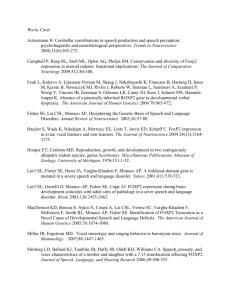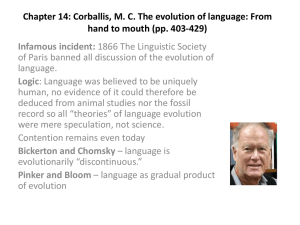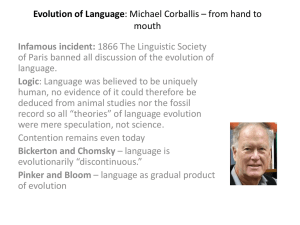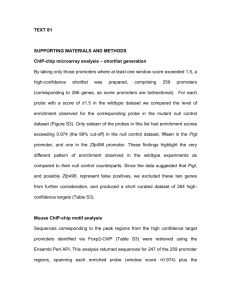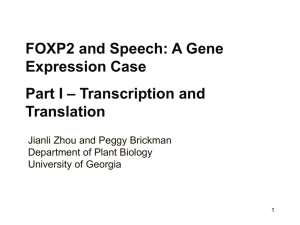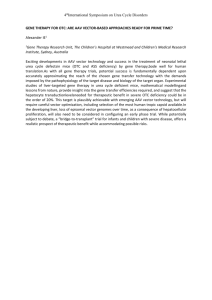Alison Poulson Introduction In 2001, scientists discovered a gene
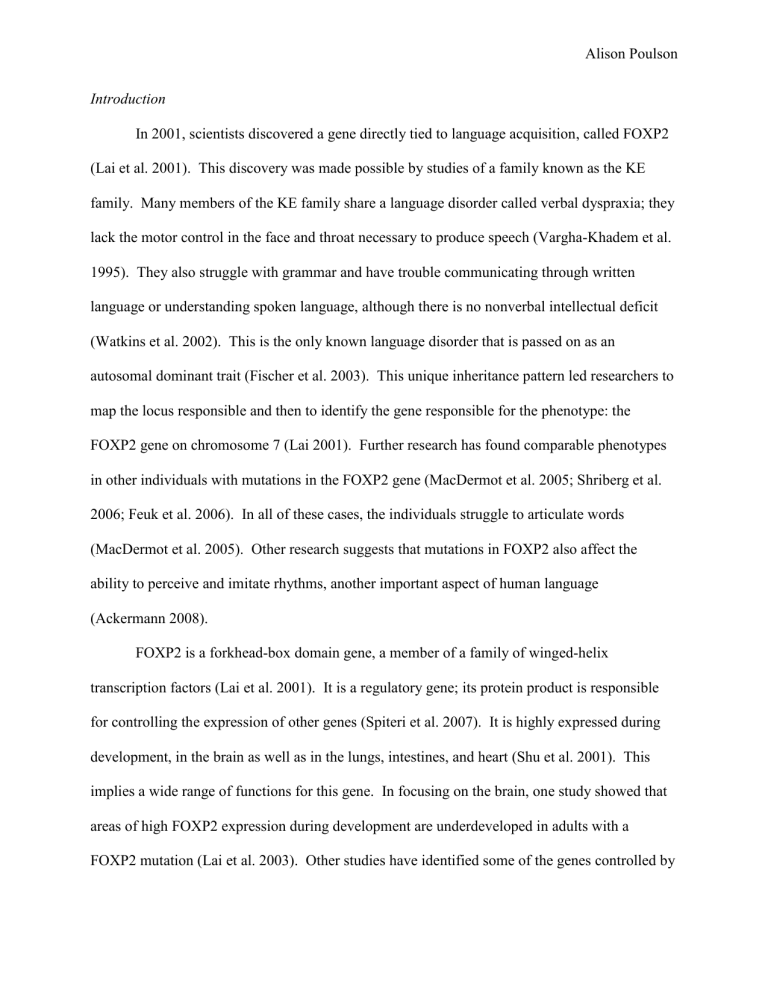
Alison Poulson
Introduction
In 2001, scientists discovered a gene directly tied to language acquisition, called FOXP2
(Lai et al. 2001). This discovery was made possible by studies of a family known as the KE family. Many members of the KE family share a language disorder called verbal dyspraxia; they lack the motor control in the face and throat necessary to produce speech (Vargha-Khadem et al.
1995). They also struggle with grammar and have trouble communicating through written language or understanding spoken language, although there is no nonverbal intellectual deficit
(Watkins et al. 2002). This is the only known language disorder that is passed on as an autosomal dominant trait (Fischer et al. 2003). This unique inheritance pattern led researchers to map the locus responsible and then to identify the gene responsible for the phenotype: the
FOXP2 gene on chromosome 7 (Lai 2001). Further research has found comparable phenotypes in other individuals with mutations in the FOXP2 gene (MacDermot et al. 2005; Shriberg et al.
2006; Feuk et al. 2006). In all of these cases, the individuals struggle to articulate words
(MacDermot et al. 2005). Other research suggests that mutations in FOXP2 also affect the ability to perceive and imitate rhythms, another important aspect of human language
(Ackermann 2008).
FOXP2 is a forkhead-box domain gene, a member of a family of winged-helix transcription factors (Lai et al. 2001). It is a regulatory gene; its protein product is responsible for controlling the expression of other genes (Spiteri et al. 2007). It is highly expressed during development, in the brain as well as in the lungs, intestines, and heart (Shu et al. 2001). This implies a wide range of functions for this gene. In focusing on the brain, one study showed that areas of high FOXP2 expression during development are underdeveloped in adults with a
FOXP2 mutation (Lai et al. 2003). Other studies have identified some of the genes controlled by
Alison Poulson the FOXP2 protein and have shown how changing the amount of FOXP2 protein in the cell changes the transcription rate of these genes (Spiteri et al. 2007; Vernes et al. 2007). However, it is still unclear how FOXP2 affects the ability to produce language.
In order to better understand its function, Foxp2 has been extensively studied in animal models (conventionally, FOXP2 is capitalized when discussing humans, but written Foxp2 in mice, and FoxP2 in other animals or mixed groups). Foxp2 has been studied particularly in songbirds, as these are some of the few species besides humans that learn vocalizations and change them over the course of a lifetime. FoxP2 is expressed similarly in songbird and human brains, and its level of expression is different in vocal-learning and non-vocal-learning birds, as well as when males are learning new songs (Teramitsu et al. 2004; Haesler et al. 2004). This is evidence for the use of FoxP2 in other species’ vocal learning. However, the FoxP2 gene has mutations in humans that are not shared with any other species. Vocal-learning birds, as well as dolphins, whales, and bats, do not have the same version of FoxP2 as humans do, and the exact differences between the different versions are not understood (Haesler et al. 2004).
A study of developing brain cells in mouse and human embryos showed that FoxP2 is expressed in very similar parts of the brain in the two species, indicating that the mouse is a good model for understanding how FOXP2 is used in the human brain (Lai et al. 2003). Another study found that mice that are heterozygous knockouts for this gene have developmental delays in gross motor skills and that the vocalizations they produce when separated from their mothers are significantly different from those of normal mice (Shu et al. 2005). These results indicate that a Foxp2 mutation in mice has effects on the same skills as it does in humans: motor control and vocalization. Scientists presume that a lack of FoxP2 during development affects an
Alison Poulson organism's ability to control the orofacial muscles necessary for speech or complex vocalizations
(Lai et al. 2003).
One study investigated the expression of Foxp2 in two varieties of singing mice,
Scotinomys teguina and Scotinomys xerampelinus , with its expression in the closely-related deer mouse and the common lab mouse (Campbell et al. 2009) .
The Scotinomys family is known for innate vocalizations, called songs because of their long duration and complexity (Hooper and
Carleton 1976). These songs use repetitive sounds modified in frequency, amplitude, and time, requiring specialized orofacial control (Miller and Engstrom 2007). Researchers found, however, that Foxp2 was expressed similarly in all four species; there was no difference in the region of Foxp2 expression in singing mice and non-singing mice (Campbell et al. 2009). One possible explanation is that Foxp2 is only involved in learned vocalizations, not innate ones (see
Haesler et al. 2004). Alternatively, Foxp2 may be involved in a pathway common to many species that is only somewhat modified for learned vocalizations (Campbell et al. 2009). This study suggests that Foxp2 is involved in fine motor responses to input, motor timing, and auditory and visual responses to stimuli. The researchers posited three major areas influenced by
Foxp2 expression: control of fine motor skills based on input from the thalamus and limbic cortex, motor timing controlled by the olivocerebellum, and the response to sensory input in the thalamus (Campbell et al. 2009). Further research in all of these areas will help more precisely identify the role of Foxp2.
This study will investigate how knocking out Foxp2 affects motor timing in the vocalizations of singing mice Scotinomys teguina and Scotinomys xerampelinus. If Foxp2 affects the way the olivocerebellum controls timing, as Campbell et al. (2009) have suggested it does in mice and Ackermann (2008) in humans, silencing the expression of this gene should
Alison Poulson have observable effects on the calls of adult singing mice. The study will compare heterozygous
Foxp2 knockouts with wild-type mice for the number and complexity of their songs at adulthood. Calls will be compared based on variation in amplitude and frequency in the course of each song, and on the production of calls in intersex and intrasex contacts. Two types of knockout mice will be studied, those with the gene knocked out during the development and those with the gene knocked out only at adulthood, to see if Foxp2 is necessary for the calls themselves or only in developing the systems necessary for calls. The brain development and motor skills of the two types of knockouts will also be compared with the wildtype mice. The developmental knockouts should show underdevelopment in areas of the brain correlating with that of the KE family and a lack of control of gross motor skills. I hope to show that the adultonset knockouts have normally-developed brains but lack control in fine motor skills in learned behaviors. I also predict that their calls will be significantly different from those of the wildtype mice in complexity and that they struggle to produce calls in normal social situations. This would show that Foxp2 is used in the adult mouse brain to respond to stimuli with the fine motor control and motor timing necessary for vocalization.
